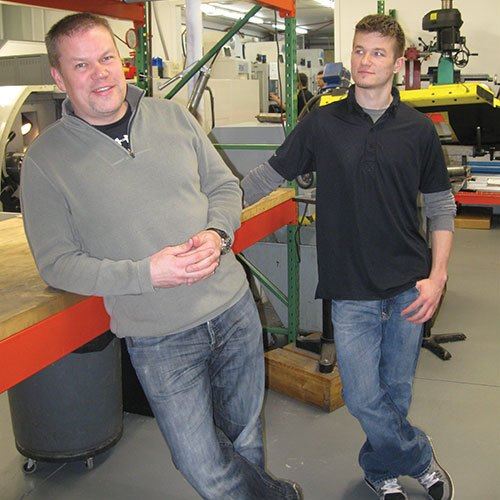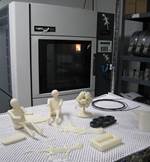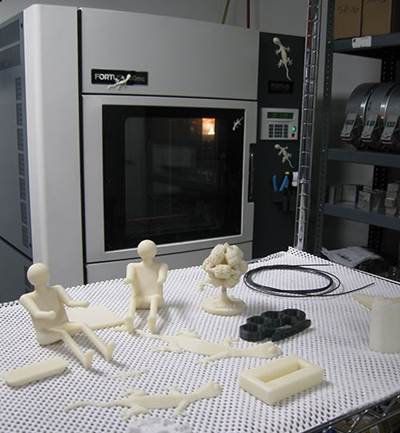Additive Manufacturing in the Job Shop
This small shop invested in production 3D printing in part because its owner expects other manufacturers to make the same move. He wanted a head start.
Should a job shop have additive manufacturing capability? Jon Baklund thought his own shop should. Further, he guessed that if he waited until his shop truly needed the capability—that is, if he waited until competing shops had it—then he would miss some of the best opportunities for his own company to be distinctive in this area. He could not have known how right this guess would prove to be.
His company is Baklund R&D of Hutchinson, Minnesota. The eight-employee shop with seven CNC machines added a Stratasys Fortus 400M 3D printer, a machine for building complex plastic parts from CAD files in a precise layer-by-layer process. Andy Bleck, business development manager for Baklund R&D, says simply having this capability in-house has been a significant asset in capturing the attention of prospective customers. He encourages the interest by sending out 3D-printed sample parts. Prospects with no additive manufacturing capability in their supplier bases take notice, because many of them recognize that some of their current or future components might be candidates for this type of production. Thus, 3D printing begins conversations, and some of those conversations lead to CNC machining work. In these cases, Mr. Baklund says the machine essentially serves as a loss leader.
Not that there’s anything wrong with that. In one of these cases in which 3D printing opened the door to a new business relationship, the work that came through that open door was precision mold machining for a medical device company. The tiny-cavity molds featured micron-level tolerances that took advantage of the fine accuracy and repeatability of the shop’s most expensive machine, an Enshu 460GH horizontal machining center. That machine had been purchased for a recurring job that had not recurred in a while, so winning this mold work was a relief, Mr. Baklund says. It was also an interesting development, given that Baklund R&D has not historically been a mold shop. (It is one now.)
Why a 3D printer? Mr. Baklund says the reason for investing in this machine has to do with the type of business he views his shop to be. Fused deposition modeling (FDM), the additive manufacturing process employed by the Fortus machine, is able to create functional plastic parts spanning an application range from prototyping through to full, mature production. Baklund R&D needs to span the same range, the shop owner says. The best way he sees to serve his customers—indeed, the best hope he sees for becoming indispensable to them—is to not only produce customer parts, but also obtain customers’ permission to guide them toward part designs that are as low-cost to manufacture as possible. The shop’s ability to generate proposed models through 3D printing is a natural fit for conversations with customers that take this form. Mr. Baklund calls this kind of relationship “suggestive engineering,” and additive manufacturing has dramatically escalated how suggestive it is practical for him to be.
In fact, he doesn’t even have to wait for a customer. Recently, he had an idea for an improved cigar case design. Cases he himself had used did not hold the humidification packet well, and he imagined a design to fix this shortcoming. With very little investment in time—less than an hour—he was able to model the idea in CAD and print the part on the Fortus machine. This is how far and how quickly his ideas can now proceed. Soon, he will take this prototype cigar case to relevant companies, hoping to find the prospect that likes this design well enough to hire his shop to begin producing it.
Additive Production
Despite all of these benefits of having a 3D printer, however, the machine will also have to move beyond prototyping, beyond being a conversation piece, and into full production. To pay for itself through its own direct profit, the 3D printer will have to manufacture end-use parts.
This is starting to happen. Production jobs for additive manufacturing have been slow to come to the shop, in part because customers are not yet familiar enough with the capability to design components with additive manufacturing in mind. In the early months, prototyping work plus limited production runs filled about 15 hours per week on the machine. More recently, a surge of medical device work increased machine use significantly. Mr. Baklund says supplementing even the previous, lighter level of demand with just one significant ongoing production job would be enough to pay for the 3D printer outright—and the shop will soon begin such a job.
The part is a precision component for the electronics industry that had been made from stainless steel at a price of $6,000 per piece. Producing a comparable part in engineered plastic through 3D printing will lower the price to just $600 per piece. Significantly, though, obtaining this savings involved far more from Baklund R&D than just opening the CAD file and hitting “print.” Additive manufacturing is not necessarily easy.
In the case of the electronics industry part, finding the additive build cycle that could hold all of this part’s tolerances, and do so within an efficient cycle time, involved the trial and error of making the part in different orientations to see which worked best. It also involved adjusting various parameters of the cycle to see which set of conditions minimized both part distortion and cycle time. The shop built and discarded at least 10 samples, with hours of cycle time devoted to each one, before it found the formula to produce this part both accurately and efficiently. Mr. Baklund says part of what is striking about this is that the shop came close to not having the ability to perform this kind of experimentation.
His initial interest in additive manufacturing focused on lower-level machines, he says. FDM produces a plain-looking part, and he was looking at 3D printing choices with more color and visual appeal. But FDM’s strength is, literally, strength. The process outputs plastics that have the same rigidity and resilience as comparable molded plastic materials. What’s more, the Fortus machine applying this process is an industrial 3D printer that gives a high level of control over parameters of the cycle, including the resolution and tool path of the build process. This control provides the freedom to refine the process until it can produce an acceptable part. Mr. Baklund credits Mike Nagle, a representative of Advanced Technology Systems, which is a sales agent for Stratasys equipment, with helping him to see the importance of these virtues. True, the result was essentially an upsell from the type of machine Mr. Baklund was considering, but he remains grateful nevertheless. He says he passes along the same advice to other shops considering 3D printing: Buy a machine that’s ready to move beyond prototyping into production, because the 3D printing jobs will increasingly be making that same move.
Credibility
His customers don’t dispute this, he says. Many or most of them assume that some significant share of their production will be performed through additive manufacturing in the future. They just don’t know how large that share will be or how soon that future will come. Baklund R&D’s 3D printer opens the door to new relationships because it makes clear to customers that the shop is committed to exploring this capability with them.
In fact, an important part of that exploration is discovering which parts do not make sense for additive production, he says. Why 3D printing? For Baklund R&D, a major reason why this capability is important is the credibility it gives this shop in identifying for customers which workpieces still demand CNC machining.
Related Content
Two 12-Laser AM Machines at Collins Aerospace: Here Is How They Are Being Used
With this additive manufacturing capacity, one room of the Collins Iowa facility performs the work previously requiring a supply chain. Production yield will nearly double, and lead times will be more than 80% shorter.
Read MoreHow Machining Makes AM Successful for Innovative 3D Manufacturing
Connections between metal 3D printing and CNC machining serve the Indiana manufacturer in many ways. One connection is customer conversations that resemble a machining job shop. Here is a look at a small company that has advanced quickly to become a thriving additive manufacturing part producer.
Read MoreVideo: 5" Diameter Navy Artillery Rounds Made Through Robot Directed Energy Deposition (DED) Instead of Forging
Big Metal Additive conceives additive manufacturing production factory making hundreds of Navy projectile housings per day.
Read More3D Printed Titanium Replaces Aluminum for Unmanned Aircraft Wing Splice: The Cool Parts Show #72
Rapid Plasma Deposition produces the near-net-shape preform for a newly designed wing splice for remotely piloted aircraft from General Atomics. The Cool Parts Show visits Norsk Titanium, where this part is made.
Read MoreRead Next
Baklund: Lessons About Additive
Make extras. Make the part before even winning the job. Additive manufacturing encourages atypical strategies such as these.
Read More3D Printed Polymer EOAT Increases Safety of Cobots
Contract manufacturer Anubis 3D applies polymer 3D printing processes to manufacture cobot tooling that is lightweight, smooth and safer for human interaction.
Read MoreCrushable Lattices: The Lightweight Structures That Will Protect an Interplanetary Payload
NASA uses laser powder bed fusion plus chemical etching to create the lattice forms engineered to keep Mars rocks safe during a crash landing on Earth.
Read More





























